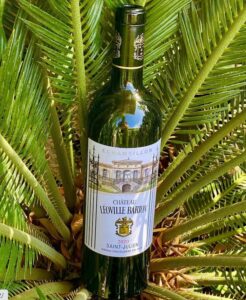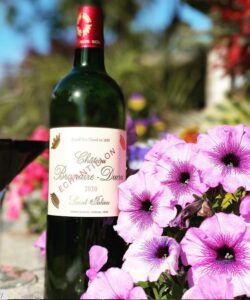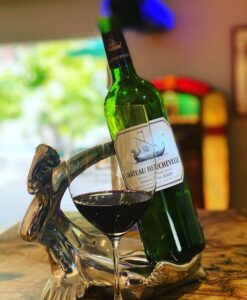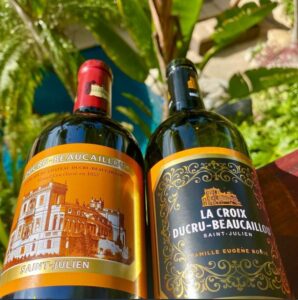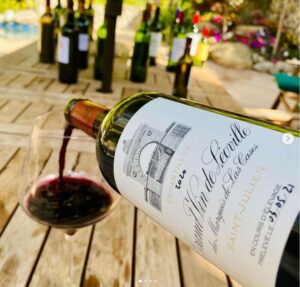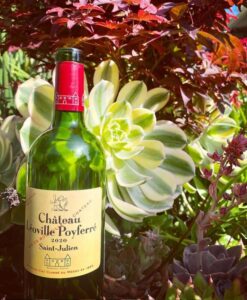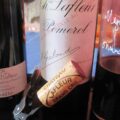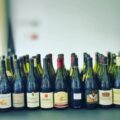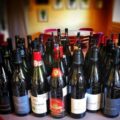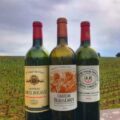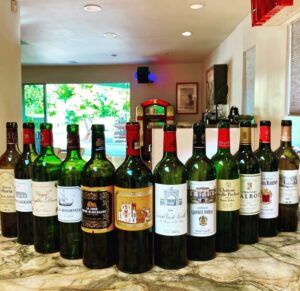
2020 Saint Julien wines are consistently good. They might not make you forget 2016, or 2018, but 2020 is not that far behind in quality. Stylistically, the wines balance opulence with freshness. They are dark in color, extremely aromatic and due to lower levels of alcohol than you find in other recent, high-quality vintages, the wines offer more vibrancy in their fruit.
2020 St. Julien wines are in large part, shaped by the hot, dry, sunny, summer conditions and drought conditions. Of course, the vintage is much more complex. You had an extremely wet and warm spring which gave birth to a precocious growing season and an early harvest.
All of these weather issues insured that 2020 St Julien will be seen as a puzzling vintage with contradictions. Philippe Blanc of Chateau-Beychevelle calls it paradoxical.
“2020 St. Julien is an early vintage because of the hot, dry conditions. Hot and dry should mean high alcohol, but 2020 is lower in alcohol than 2018. Also, drought vintages are usually lower acidity. The wine can be flabby. With 2020 Saint Julien, even though the pH is around 3.80, clearly, there is freshness, brings elegance and length.”
The growing season was warm even before the summer. In fact, May entered the record books as the 4th warmest month in eight decades! At its peak, temperatures rose to 30 Celsius, 86 Fahrenheit, hastening the pace of the vintage. Flowering took place 10 days faster than usual, making 2020 Bordeaux an early vintage.
Temperatures cooled down in early June, which was a good thing, as that decelerated the growth rate. June started out with cool and rainy weather.
The remainder of the summer was hot, sunny, and extremely dry. In fact, almost 30 days saw temperatures of 30 Celsius, (86 Fahrenheit) and at least 6 days endured temperatures of 35 Celsius, (95 Fahrenheit.)
July was marked by drought conditions, which continued through to August.
Here is where the differences in terroir came into place. Water retentive clay and limestone soils were able to nourish the vines. Vineyards with dry, warm gravelly soils suffered from vines that stopped their growth cycle. Young vines as you would expect suffered the most.
Lilian Sartorius Barton of Chateau Leoville-Barton remembers the heat during the harvest.
“With 2020 Saint Julien, it was an early harvest with a lot of heat. The grapes were coming in very hot so we needed to place dry ice in our vats before putting the grapes in. The result is surprising! Some lovely wines with dark colors and black fruit with freshness, long tannins, and not too much alcohol.”
Vine stress was potentially a serious issue. Young vines were clearly suffering. Another heatwave hit the region in August. Fortunately, Bacchus loves Bordeaux because just when the vines needed it the most, the region experienced much-needed rains which fell from August 9 to August 14. As the moisture was delivered following véraison, the vines reignited their growth cycle.
While rain fell all over Bordeaux, on average, vineyards to the north experienced more rain than St. Julien which saw roughly 86mm, (3.85″), which was less than St, Estephe and Pauillac, but more than their neighbors to the south in Margaux and Pessac Leognan.
By the end of September, things were looking up. September started hot, sunny and dry. But because the nights were cool, the grapes were able to maintain acidity. These good conditions lasted until September 20, when the weather cooled down. It was as if fall weather conditions started to kick in with temperatures in the daytime dropping to almost 12 Celsius, (54 Fahrenheit!) in the northern Medoc. The unseasonably cool temperatures continued through the harvest period.
Picking began for young Merlot vines in the early part of September, which is quite early. For the most part, Cabernet Sauvignon was picked after the Merlot. But that was not always the case. Many Left Bank vineyards were picking Cabernet while Merlot was still being harvested starting in early to mid-September. For some vignerons, 2020 turned out to be the earliest vintage since 1989.
Even though 2020 St. Julien was an early harvest, because the vintage got off to an early start, the grapes were able to remain on the vine with an extended hang-time, which Jean-Michel Laporte Chateau-Talbot credits as playing a role in the success of the vintage.
“The main point in 2020 for me is the length of the physiological cycle of the vines. Flowering was 2 weeks early, but we finally harvested with an average of 5-6 days of advance only. That permitted us to get a wonderful maturity, especially for the Cabernet Sauvignon.”
The difficulties in the growing required a light touch and steady hand during the vinifications says Francois-Xavier Maroteaux of Chateau Branaire-Ducru.
“As you can imagine, the extraction period was a particularly important moment this year! We needed to really be careful in order to keep all these elements at the perfect levels.”
For a much more detailed report on the 2020 Bordeaux growing season and harvest
While the Cabernets in some vineyards did not achieve full ripeness, the berries were small, with thick skins a well as being intensely concentrated with massive amounts of tannins and anthocyanins. This allowed for high-quality wines with great color, aromatics, and refinement, but without the levels of concentration, intensity and also alcohol found in 2018.
Sara Lecompte-Cuvelier of Chateau Leoville-Poyferre said 2020 is a memorable vintage for several reasons, not just due to the quality of the wine, but for their historic family celebration.
“2020 bookmarks the 100 years of the estate in my family. As for 2020 St. Julien, it is a great vintage that offers the depth of 2018 and the charm of 2019, along with more freshness and lower alcohol levels.”
The best 2020 Bordeaux should age quite well. According to Bruno Borie of Chateau Ducru-Beaucaillou, the best wines will age for decades.
“The high level of tannins and anthocyanins guarantee wine lovers will be able to age these wines for decades. Even though the wines can age for generations, what is special about this vintage is that the wines can also be enjoyed in their youth!”
The following 2020 St. Julien wines were all tasted in my home office in non-blind conditions.
2020 Beychevelle – Dark garnet in color, the wine shows off its black currants, licorice, wet forest floor, tobacco leaf, creme de cassis and blue fruit on the nose effortlessly. Full-bodied, fresh, elegant, lifted and vibrant, the wine is refined, juicy, sweet and long, with an ending packed with ripe, red and black currants, silky tannins, spice and crushed stones from start to finish. Made from blending 51% Cabernet Sauvignon, 45% Merlot and 4% Petit Verdot, 13.45% ABV, pH 3.8. 55% of the harvest was used in the Grand Vin. 95-97 Pts
2020 Amiral de Beychevelle – On the fruity side, the wine is loaded with currants, cherries, cranberries, and touches of flowers with tobacco. The wine is medium-bodied, soft, forward, refined, fresh and with a touch of dust in the finish. The wine is already approachable. Drink this while waiting for the Grand Vin to mature. 88-90 Pts
2020 Branaire Ducru – Cedar, tobacco, red and black currants, mocha, spice and smoke come through loud and clear in the nose. Soft, silky and supple, the fresh red fruits are already quite expressive creating a refined, medium/full-bodied, silky, wine with purity, character and precision. This will drink well with 7–8 years of aging and will age and develop quite nicely. 93-95 Pts
2020 Ducru Beaucaillou – Richly colored, the wine delivers a complex nose of cigar box, tobacco leaf, wet forest floor, camphor, red and black currants, blackberry and creme de cassis. Supple, sensuous, elegant and concentrated, the wine focuses on its refined character, purity of fruit and silky textures. Long, vibrant and incredibly refined, the finish builds as it lingers. This gem should start to really unfurl after its 10th birthday and provide fabulous drinking for 25-35 years after that. Not as powerful as some recent vintages, instead this is a stunningly graceful Ducru Beaucaillou. Produced from blending 81% Cabernet Sauvignon and 19% Merlot, 13.5% ABV. Picking took place September 11 – September 30. Yields were low at close to 30 hectoliters per hectare. 97-99
2020 La Croix Ducru-Beaucaillou – Tobacco, cedar, mint leaf, cigar box and black currants come together on the nose. The wine is refined, soft and supple with silky tannins, ripe, sweet, fruits, lift and freshness. The elegant finish with its black cherry, mocha and spice nuances tastes as good as it feels. Hold this for 3-5 years before opening a bottle and it will really start showing its essence. The wine is a blend of 53% Cabernet Sauvignon, 44% Merlot and 3% Petit Verdot. 92-94
2020 Ducru Beaucaillou Le Petit Ducru – Tobacco, spice and red fruits come forward easily. Medium-bodied, soft, supple, fresh and forward define this wine. This charmer is already a pleasure to drink, you can think of it as a baby Ducru Beaucaillou, as it is essentially the third wine of Ducru. 90-92 Pts
2020 Gloria – Tobacco, cedar and black currants create the nose. On the palate the medium-bodied wine is soft, refined, elegant, fresh and a touch savory, finishing with blackberry, cocoa, currants, and earth. Give this 4-6 years in the cellar and enjoy it for about 2 decades after that. 92-94 Pts
2020 La Bridane – Flowers, cherries and a touch of oak fill in the perfume. On the palate, the wine is soft, medium-bodied, fruity and savory with a dusty texture to the bright, crisp, red currant and cherry profile in the finish. 87-89 Pts
2020 Lagrange – Dark garnet in color, the nose, with its tobacco leaf, cedar, cigar box, forest leaf, flowers and cassis is enthralling. Full-bodied, concentrated, big, juicy and fruity, there is a lot of life here. The fruits are ripe, creamy, spicy, long and vibrant and they not only work on the mid-palate, they carry through to the extended finish. Starting with the 2018 vintage, Lagrange has been on a hot streak. 93-95 Pts
2020 Langoa Barton – Spicy, sweet, fresh, vibrant aromas of currants, cedar, cigar box, herbs and spice meld perfectly with the powerful, ripe, long, waves of red fruits. Here you find, bite, and crispness to the fruit, a full-body with grainy tannins needing time to expand and soften. The finish, with its tobacco, red currant, cranberry and spice keeps on going. Give this a decade and it should really start to shine. 93-95 Pts
2020 Leoville Barton – Inky in color, it takes only one sniff to see how much ripe fruit is packed in here. Blackberry, currants, smoky cherries, tobacco leaf, cedar, flowers and creme de cassis aromas come on strong. The wine is full-bodied, bold, powerful, tannic, balanced and fresh. The palate filling finish is long, energetic, rich and expansive. This is a superb vintage of Leoville Barton that will need at least a decade in the cellar and will age and evolve for another 2-3 decades after that. 95-97 Pts
2020 Leoville Las Cases – Dark garnet in color, the wine pops with aromas of tobacco leaf, cigar box, cedar, herbs, black currants, coffee and spice. Refined, fresh, polished and firm, the fruit is vibrant, long and intense. The tannins are ripe almost creamy in texture. The finish is long, regal and compelling, leaving you with layers of black currants and cassis. Give this at least 12-15 years before popping a cork and enjoy it for the next 3 decades after that. The wine is a blend of 81% Cabernet Sauvignon, 11% Merlot and 8% Cabernet Franc, 13.68% ABV, 3.80 pH. The harvest took place from September 12 – September 27, making this the earliest vintage since 1989. 96-98 Pts
2020 Clos du Marquis – Flowers, cassis, black raspberries, herbs and tobacco leaf on the nose. Medium-bodied, forward, juicy, soft and polished, there is energy, freshness and purity here from start to finish. The wine was made from a blend of 61% Cabernet Sauvignon, 33% Merlot and 6% Cabernet Franc. 93-95 Pts
2020 Le Petit Lion de Marquis de Las Cases – Elegant, refined and fresh, the wine is packed with tobacco leaf, cherry, cedar and spice. Medium-bodied and lifted, with gorgeous notes of kirsch, cassis and smoky cherries on the palate and in the finish, this baby Leoville Las Cases is going to be just great with only a year or two of age. The wine blends 50% Cabernet Sauvignon, 44% Merlot and 6% Cabernet Franc. 91-93 Pts
2020 Leoville Poyferre – Silky, polished, lusciously textured and rich, the wine pops from the glass with incense, smoked berries, cherry blossoms, creme de cassis, tobacco leaf and blue fruit. Full-bodied, silky and opulently textured, this concentrated wine offers layers of deep, ripe fruits that simultaneously coat your palate, yet feel fresh and vibrant. The flamboyant, seamless finish builds in intensity as it expands on your palate. 96-98 Pts
2020 Leoville Poyferre Pavillon de Léoville Poyferré – Medium-bodied, spicy, savory and loaded with cedar and cigar box aromas, the wine is soft, fresh and fruity, finishing with plush textured, sweet, red berries and silky tannins. Drink this beauty while waiting for the Grand Vin to develop. 90-92 Pts
2020 Les Ormes – Tobacco leaf and currants shine through on the nose and on the soft, medium-bodied palate. Forward and accessible, the wine delivers a nice currant note in the savory, chewy finish. 86-88 Pts
2020 Moulin-Riche – Showing a nice depth of color, the wine opens with espresso, cedar, cigar box, tobacco leaf and black currants. Medium/full-bodied with round, lush textures and layers of sweet, supple textured fruits in the finish, this is the finest vintage of Moulin Riche I have ever tasted. 90-92 Pts
2020 Saint-Pierre – Seductive, with loads of ripe, dark, fresh, polished, earthy, black currants, cedar, toasty oak, licorice and spice. The wine is soft, polished, fresh and focused, leaving you with layers of deep ripe fruits, a touch of coffee bean, cocoa and currants. This should age and evolve for 25 years or more. 93-95 Pts
2020 Talbot – The array of flowers and fruits here, blackberry, black currant, kirsch and cassis is just great! Concentrated, fresh and lifted, the wine is long, elegant, and expansive with a solid touch of minerality and crispness to the fruits on the palate and in the finish bringing complexity and ageability here. This is going to be just great with 7-9 years of aging. Things continue improving here under the direction of Jean-Michel Laporte. 93-95 Pts
2020 Talbot Connetable – Medium-bodied, early-drinking, soft, forward, bright, spicy, fresh red currant and espresso-filled wine that will show best in its youth. 88-86 Pts
2020 Talbot Caillou Blanc – Floral with white peach, tangerine, pineapple and lemon rind on the nose, the wine is fresh, bright and lifted, with a rich, lush, creamy sweet finish and balancing acidity. 92
If you have any questions or comments, please feel free to post.
The next article to be published is on 2020 Margaux wines with tasting notes, ratings and more.

